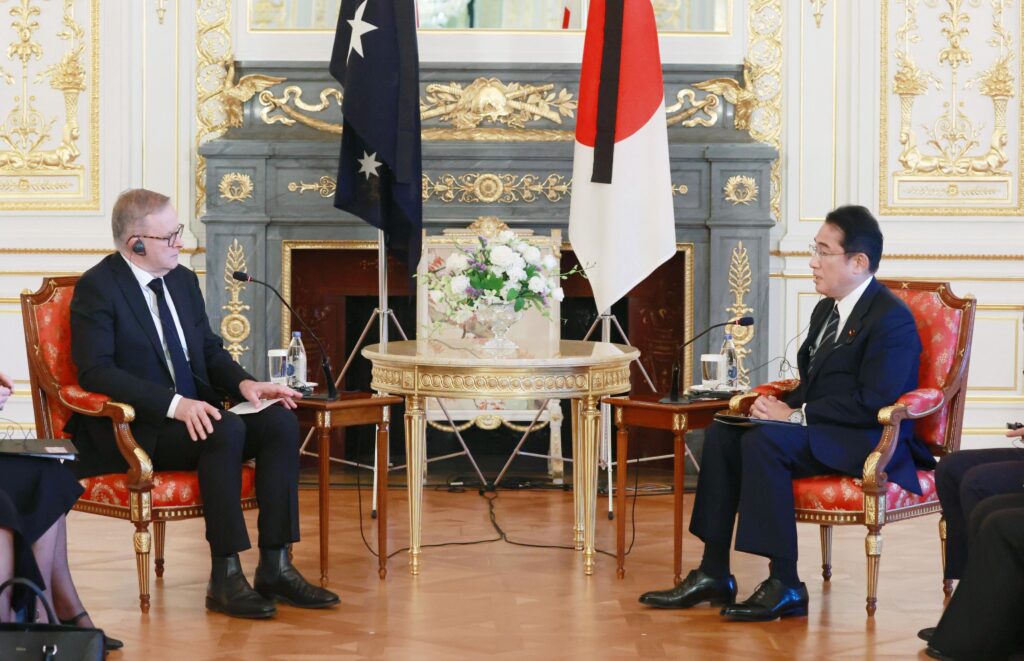Middle powers such as Australia and Japan have leveraged minilateral relationships to achieve shared security and economic objectives. But since the minilateralism pursued by Canberra and Tokyo has largely been a response to the rise of China, this raises the question of how Beijing practices minilateralism and what this might reveal about the effectiveness of the Japanese and Australian approach.
The appeal of China’s approach in the Global South should give Canberra and Tokyo pause. Australian and Japanese minilateralism, while containing governance and economic elements, is widely perceived as being dominated by ‘hard security’. This means that their minilateralism has less appeal to developing countries, since it does less to support the lives of the vulnerable through the UN Sustainable Development Goals (SDGs).
Australia and Japan must uncover ways to engage with these countries outside traditional security issues. The Partners in the Blue Pacific initiative is the most obvious vehicle but others should be considered, perhaps seeking to tie up existing national initiatives such as the ‘Pacific Step up’ and ‘Pacific Bond’ policies with bilateral initiatives to create a broader minilateral framework.
China opposes US centricity and will likely distrust Japanese and Australian minilateralism. Certainly, it has denounced institutions such as the Quad as a ‘NATO-style gang’. But less well-known is the fact that Beijing has employed minilateralism for decades, although it does not explicitly refer to it as such.
China has been experimenting with minilateralism since well before the recent upsurge in Indo-Pacific minilateralism initiated by the United States and its partners. The Shanghai Cooperation Organization (SCO) began as the ‘Shanghai Five’ minilateral grouping in 1996. In 1999 Beijing began talks with Tokyo and Seoul that evolved into the Trilateral Cooperation Secretariat, designed to ‘promote lasting peace, common prosperity and shared culture.’ China also helped form BRICS with Brazil, Russia, India, and South Africa in 2009.
In contrast to the alliance-centric approach of Australia and Japan, China has sought to connect minilateral initiatives with bilateral and multilateral arrangements in a multi-layered approach. Minilateralism with ‘Chinese characteristics’ falls into several, sometimes overlapping, categories — security, networked, economic and informal.
On security, BRICS was originally advertised as being focused on economic governance but has subsequently developed an interest in security governance. Organised on the principles of ‘non-interference, equality, and mutual benefit’, it is increasingly interested in global security challenges such as terrorism, nuclear proliferation issues and the world order. The BRICS experience indicates that Chinese minilateralism can evolve from economics to security.
For networked minilateralism, China has sought to create bilateral partnership agreements in ways that lead to a more networked set of relationships. These partnerships are typically categorised in order of importance.
They include a ‘comprehensive strategic partnership of coordination’ with Russia, an ‘all-weather strategic cooperative partnership’ with Pakistan and ‘comprehensive strategic cooperative partnerships’ with a range of countries. These partnerships have developed based on ‘the need to counter the US pressure, the necessity of maintaining peace and stability along its borders and achieving the long-term goal of modernization’. When these partnerships appear with minilateral (or multilateral) institutions together they generate a ‘networked’ effect.
In terms of economic cooperation, the most obvious candidate is the Lancang Mekong Cooperation (LMC) mechanism. This minilateral seeks sustainable management of hydro resources and joint development of the Mekong sub-region, with reference to the UN’s SDGs. The LMC is closely linked with Chinese-led multilaterals such as the Belt and Road Initiative, and oftentimes predicated upon bilateral agreements, and layers atop regional governance and non-traditional security cooperation.
Finally, China’s more informal minilateral groupings include its attempts to engage with ‘groups of friends’ within the UN. Beijing has sought to lead more formal arrangement along these lines within its Global Development Initiative (GDI). Informal arrangements are also apparent in China’s conflict mediation efforts, such as the Quadrilateral Coordination Group and the Russia–China–Pakistan Trilateral Dialogue.
China appears to see minilateralism as part of a complex web of overlapping and interlocking bilateral, multilateral and sub- or cross-regional arrangements. Beijing uses minilaterals to expand its participation in regional and global governance and entrench its legitimacy.
Compared to Australian and Japanese security-centred minilateralism, China focuses on geoeconomic and governance priorities. It designs minilateral tools to gain influence in the developing world by assisting with development needs rather than overtly addressing strategic competition with the US and its allies, though there are growing signs of ‘security creep’ in the BRICS and LMC cases.
If Canberra and Tokyo hope to build an order attractive to the region, they must expand their minilateral approaches and strengthen the economic and governance dimensions of their minilateral agenda.
Miwa Hirono is Professor and Associate Dean in the College of Global Liberal Arts at Ritsumeikan University.
H.D.P. Envall is Fellow / Senior Lecturer in the Department of International, Coral Bell School of Asia Pacific Affairs, Australian National University, and an Adjunct Research Fellow at La Trobe University.
Kyoko Hatakeyama is Professor of International Relations at Graduate School of International Studies and Regional Development, University of Niigata Prefecture.
Thomas Wilkins is Associate Professor at the University of Sydney and a Senior Fellow at the Australian Policy Institute (ASPI), as well as non-resident Senior Fellow at the Pacific Forum and the Japan Institute for International Affairs (JIIA).
This article was written with the generous support of the Australia-Japan Foundation.


Australia and Japan's ‘hard security’ minilateralism focuses on countering China but lacks appeal for developing nations. By contrast, China uses multi-layered minilateralism (security, networked, economic, informal) to advance geoeconomic and governance priorities, offering development assistance and building broader relationships. To compete, Australia and Japan should expand their minilateral agenda beyond security, focusing on economics and governance to offer developing nations a compelling alternative.